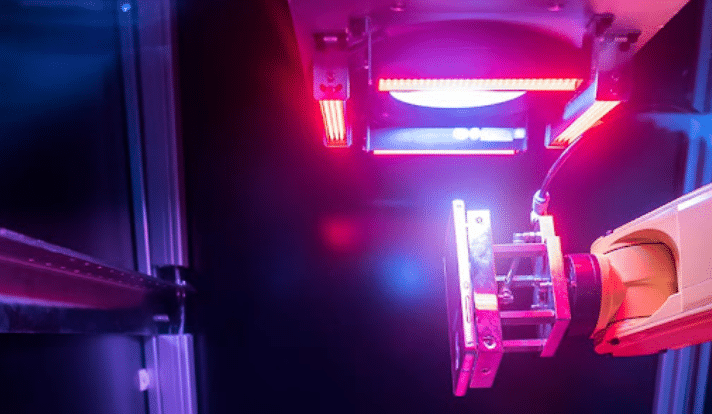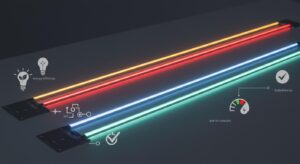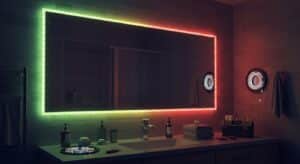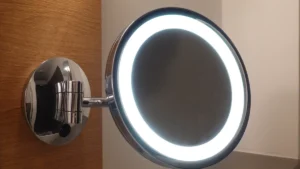
Machine vision LED strips are special lights used in machines. They give steady and controlled light for better image quality. This helps with accurate inspection, detection, and automation tasks. These strips provide even lighting, which improves imaging system accuracy. Adding them to factories makes work faster and reduces mistakes. These lights are very important for industries needing precise and reliable work.
Key Takeaways
Machine vision LED strips give steady light, helping take clear pictures for inspections and automation work.
These LED strips last long and save energy, cutting costs and boosting work efficiency in factories.
You can change their brightness and color to fit tasks, making them useful for many jobs.
Different lighting styles, like backlighting or ring lighting, show details better and improve image accuracy.
Using these LED strips lowers mistakes and makes work faster in areas like factories, robots, and medical imaging.
How machine vision LED strips work

The role of lighting in machine vision systems
Importance of consistent and uniform illumination
Lighting is very important in machine vision systems. Steady and even lighting helps cameras take clear pictures. Without good lighting, shadows or glare can ruin the image. This makes it hard to find flaws or measure objects correctly. Machine vision light strips fix this by giving steady, controlled light. This helps the system see even tiny details better.
How lighting affects image quality and accuracy
Good lighting makes images clearer and easier to see. Special light strips make objects stand out from the background. For example, bright flashes can block out other light for clear pictures. These lights also make it easier for computers to process images. They highlight important parts, so less work is needed. Studies show the right lighting improves accuracy and reliability by 30%.
Components of machine vision LED strips
LED technology and its advantages
Machine vision LED strips use advanced LED lights. LEDs are bright, last long, and save energy, making them great for factories. These lights stay bright even after being used a lot. Matching LED colors with camera needs makes them work better. They are also tough and work well in hard conditions.
Integration with imaging systems
Machine vision LED strips work perfectly with cameras and sensors. They are made to fit what the system needs for the best results. For example, infrared LEDs help cameras in dark places. This makes them useful for tasks like finding flaws or tracking objects.
Types of machine vision LED strips
Backlighting
Backlighting puts the light behind the object. This shows the edges clearly, which helps find cracks or check shapes.
Ring lighting
Ring lighting surrounds the camera lens with light. It lights up the object evenly and removes shadows, showing surface details better.
Bar lighting
Bar lighting uses straight light strips to light up big areas. These are great for checking flat surfaces or conveyor belts.
Dark-field and bright-field lighting techniques
Dark-field lighting shines light at a low angle to show textures. Bright-field lighting shines directly for clear, high-contrast images. The choice depends on the object’s surface and inspection needs.
Key features and benefits of machine vision LED strips
Features of machine vision LED strips
Adjustable intensity and color temperature
Machine vision LED strips let you change brightness and color. This helps match the light to different tasks. For example, brighter light works for detailed inspections. Changing color can make images clearer. This makes them useful in places with changing light needs.
High durability and long lifespan
These lights are tough and last a long time. They work well even in rough conditions. You won’t need to replace them often. This saves time and money. They are built to keep working for years without problems.
Compact and flexible designs
These LED strips are small and bendable. You can fit them into tight spaces. They can also be shaped to fit different setups. This makes it easy to use them in many systems. Their design helps meet specific needs.
Key Feature | Description |
|---|---|
Illuminate the target | Makes the target brighter for clearer pictures. |
Highlight measurement features | Shows important parts to make image processing easier. |
Overcome ambient light interference | Blocks other light for better image quality. |
Improve accuracy | Helps the system measure and recognize objects better. |
Reduce design complexity | Makes imaging simpler for easier processing. |
Benefits of using machine vision LED strips
Enhanced image clarity and precision
These LED strips make images sharper and clearer. This is great for finding defects or measuring objects. They highlight key details, making it easier to see. By reducing noise and boosting contrast, they improve accuracy.
Improved efficiency in industrial processes
These lights save energy and work well in tough places. They don’t break easily, so there’s less downtime. Their energy-saving design lowers power use. This makes them a smart choice for factories. They help speed up work and improve productivity.
Reduced maintenance and operational costs
LED strips last a long time, so you replace them less. They are strong and keep working in hard conditions. Using less energy and needing less care saves money. These lights are reliable and cost-effective for long-term use.
LED strips make images clearer for precise industrial tasks.
Their toughness ensures they work well in harsh conditions.
Energy-saving design cuts costs and boosts efficiency.
Common uses of machine vision LED strips in industries
Manufacturing and quality checks
Checking products for flaws
In factories, light strips help find product flaws. They give steady light to spot cracks, scratches, or misaligned parts. For instance, backlighting can show defects in thin or clear materials. Research shows LED-lit systems meet strict quality rules, like in car-making. This ensures every item is perfect before it reaches buyers.
Helping assembly lines work better
Light strips are key for assembly line machines. They light up big areas evenly, helping cameras see moving parts clearly. This finds mistakes quickly, cutting down on human checks. LED lights also guide robot arms for tasks like placing parts. Their long life and steady light make them great for tough jobs.
Robots and automated systems
Robots guided by vision
Robots use light strips to “see” objects around them. These lights help robots pick up and place items precisely. For example, ring lights remove shadows, making objects easier to spot. This improves how well robots work in industries like electronics and packaging.
Finding and following objects
Light strips help robots track objects. They create contrast to separate items from their background. This is useful in places where light changes often. With these lights, systems work well even in tricky conditions. They are vital for tasks like warehouse sorting and shipping.
Medical and science imaging
Microscopes and medical pictures
In medicine, light strips make tiny details clearer. They give even light, which helps doctors see better. For example, dark-field lights show fine details in samples, while bright-field lights show surface features. These lights also help find problems in tissues or cells, giving accurate results.
Automating lab work
Labs use light strips to speed up tasks like sorting samples. These lights make small items easier to see for exact measurements. Their small size fits into tight lab tools. Adding LED strips helps labs work faster and lowers mistakes in repeated tasks.
Other industries
Agriculture (e.g., crop sorting)
Machine vision systems with light strips have changed farming methods. These lights give steady brightness, helping sort and grade crops. They show small differences in color, texture, or size. This makes it easier to find bad or uneven produce. For example, in food factories, light strips improve automated checks. This ensures only the best products are sent to stores.
Light strips are also important for checking the environment. They make imaging tools better at studying soil or spotting pests. This helps farmers waste less and work more efficiently. Studies show that using LED lights in farming improves crop checks. This makes them a must-have for modern agriculture.
Security and surveillance
In security, light strips help cameras work better in all settings. They make images clearer, even in dark places. For example, infrared light strips are used in night vision to see movement or objects in the dark.
LED light strips also help watch large areas closely. They remove shadows and boost contrast, showing every detail. This is very helpful in secure places like airports or warehouses. Experts say good lighting is key for better machine vision. This makes LED light strips very important for security tasks.
Tip: When choosing light strips for farming or security, check brightness, strength, and if they fit your system.
Factors to think about when picking machine vision LED strips
Needs for specific tasks
Type of imaging system used
The imaging system you use decides the best LED strips. Cameras and sensors need special lights to work well. Fast inspections may need strobe LEDs, while dark areas might need infrared ones. LEDs are great because they last long and give steady light. Other lights, like quartz halogen or xenon, might work better for big spaces or bright flashes.
Lighting Type | Pros | Cons |
|---|---|---|
Fluorescent | Cheap for lighting large areas | Not very bright |
Quartz Halogen | Very bright | Doesn’t last long |
LED | Long-lasting, steady light | Not ideal for huge spaces |
Metal Halide | Bright for big jobs | Costs more |
Xenon | Super bright flashes | Not good for all uses |
Conditions like temperature and humidity
Temperature and humidity affect how LED strips work. Check if the lights can handle the environment. Wet places may need waterproof LEDs. Hot or cold areas might need heat-safe designs. Study the space and how light hits the target for the best results.
Aspect | Details |
|---|---|
Lighting Types | Learn about different lights and their benefits. |
Inspection Environment | Study space limits and how light works with the object. |
Acceptance Criteria | Make important parts stand out while keeping others less visible. |
Technical details
Brightness and color settings
Brightness and color settings change how clear images look. Pick LED strips that let you adjust brightness for your needs. Bright lights help with detailed checks. Changing color settings can make things easier to see. This makes the lights useful for many tasks, like finding flaws or tracking items.
Energy use and efficiency
Saving energy is important. LED strips use less power than older lights. This lowers costs and helps the environment. Check how much power the lights need before buying. Energy-saving LEDs are smart for long-term use.
Fit and setup
Easy to add to current systems
LED strips should work well with your current setup. Choose ones that are simple to install and match your tools. Plug-and-play designs make setup quick and easy. This avoids delays in your work.
Options for changes and growth
Your lights should be adjustable for future needs. You might need to change angles or add more lights later. Flexible designs let you grow your system over time. Customizable LEDs help you match the lights to different tasks, keeping them useful for many jobs.
Machine vision LED strips are important for giving steady light. They make images clearer, improve precision, and help industries work faster. These industries include factories, robots, and medical tools. Using these lights can make work smoother and cut down mistakes.
Tip: Think about what you need, like brightness and strength, before picking LED strips. The right choice will help your system work better and last longer.
FAQ
What makes machine vision LED strips special compared to regular LEDs?
Machine vision LED strips give steady, even light for cameras. Unlike regular LEDs, they let you adjust brightness and color. They also have special designs like backlighting or ring lighting. These features make images clearer and more accurate for industrial and science uses.
Can machine vision LED strips handle tough environments?
Yes, many machine vision LED strips are made to last. They can handle heat, humidity, and vibrations. Some are waterproof or heatproof, making them great for hard jobs or outdoor use.
How do I pick the best machine vision LED strip?
Think about what your system needs, like brightness and color. Check if they work in your environment, like hot or wet places. Look for adjustable designs to fit your tasks.
Tip: Always read the specs and ask experts if unsure.
Are machine vision LED strips good for saving energy?
Yes, these LED strips use less power than older lights. They save energy and lower costs while working well. This makes them a smart and eco-friendly choice for long-term use.
Do machine vision LED strips need a lot of care?
No, they are built to last and need little care. Good-quality LED strips last a long time and don’t need replacing often. This saves you time and money.
Note: Clean them regularly and install them properly to make them last longer.



